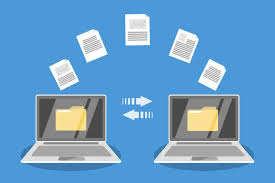Transferring files from one PC to another can be a daunting task, especially when dealing with large volumes of data. Whether you’re upgrading to a new system or simply sharing files with a colleague, it’s essential to know the most efficient methods available. In this comprehensive guide, we explore five professional ways to transfer files from PC to PC, ensuring your data is moved swiftly and securely.
Enterprise Laplink
- Overview: Enterprise Laplink is a specialized software designed for secure and efficient data migration between PCs.
- Features:
- Direct Transfer: Connect two PCs directly via network or USB cable.
- Data Synchronization: Sync files and settings between computers.
- Data Security: Encrypted transfers to protect sensitive information.
- Best For: Large-scale enterprise environments needing robust data migration solutions.
1. Using External Storage Devices
One of the most straightforward methods to transfer files is by using external storage devices. This includes USB flash drives, external hard drives, and SSDs. Here’s how you can do it:
Steps to Transfer Files Using USB Drives
- Connect the USB Drive: Insert your USB drive into the USB port of the source PC.
- Copy Files: Navigate to the files you wish to transfer, select them, and copy them to the USB drive.
- Safely Eject the USB Drive: Once the files are copied, safely eject the USB drive.
- Insert USB Drive into Destination PC: Connect the USB drive to the destination PC.
- Paste Files: Navigate to the USB drive, select the files, and paste them into the desired location on the destination PC.
Advantages of Using External Storage Devices
- Portability: USB drives are small and easy to carry.
- No Internet Required: Perfect for transferring files in areas with no internet access.
- Speed: Modern USB 3.0 drives offer high-speed data transfer.
2. Network File Sharing
Network file sharing allows you to transfer files over a local network, making it a great option for transferring files between PCs on the same network. Here’s a step-by-step guide:
Steps to Enable Network File Sharing
- Connect Both PCs to the Same Network: Ensure both PCs are connected to the same Wi-Fi network or via Ethernet.
- Enable File Sharing: On the source PC, go to the Control Panel > Network and Sharing Center > Change advanced sharing settings.
- Turn On Network Discovery and File Sharing: Under the Private network profile, turn on network discovery and file sharing.
- Share Specific Folders: Right-click the folder you wish to share, select Properties > Sharing > Advanced Sharing, and enable sharing.
- Access Shared Folders on Destination PC: On the destination PC, open File Explorer and navigate to Network. You should see the source PC and the shared folders.
Advantages of Network File Sharing
- Convenience: No need for physical devices.
- Large File Transfer: Suitable for transferring large files or folders.
- Multiple Users: Multiple users can access shared files simultaneously.
3. Cloud Storage Services
Cloud storage services such as Google Drive, Dropbox, and OneDrive offer a modern way to transfer files. This method is ideal for remote transfers and backups.
Steps to Transfer Files Using Cloud Storage
- Upload Files to Cloud Storage: On the source PC, upload the desired files to your cloud storage account.
- Install Cloud Storage App on Destination PC: Ensure the cloud storage app is installed on the destination PC.
- Download Files from Cloud Storage: On the destination PC, log in to your cloud storage account and download the files.
Advantages of Cloud Storage
- Accessibility: Access your files from anywhere with an internet connection.
- Backup: Provides a backup of your files in the cloud.
- Sharing: Easily share files with others by providing access links.
4. Using Data Transfer Cables
Data transfer cables, such as USB-to-USB cables, offer a direct method for transferring files between two PCs. These cables come with software that simplifies the transfer process.
Steps to Use Data Transfer Cables
- Connect the Cable: Connect one end of the cable to the source PC and the other end to the destination PC.
- Install Necessary Software: Follow the instructions to install the required software on both PCs.
- Start the Transfer: Use the software to select and transfer files between the PCs.
Advantages of Data Transfer Cables
- Direct Connection: Provides a direct link between two PCs.
- Speed: Faster than some network transfers.
- Ease of Use: Software typically guides the transfer process.
5. Using Software and Applications
Several third-party applications facilitate file transfer between PCs. These applications can offer additional features like file synchronization, encryption, and scheduled transfers. Some popular options include EaseUS Todo PCTrans, Laplink PCmover, and AOMEI Backupper.
Steps to Use File Transfer Software
- Install the Software on Both PCs: Download and install the file transfer software on both the source and destination PCs.
- Connect the PCs: Depending on the software, connect the PCs via a network or a data transfer cable.
- Select Files to Transfer: Use the software interface to select the files or folders you wish to transfer.
- Initiate the Transfer: Start the transfer process and wait for it to complete.
Advantages of File Transfer Software
- Comprehensive Features: Often include additional features like synchronization and backup.
- User-Friendly Interfaces: Simplify the transfer process with easy-to-use interfaces.
- Security: Many applications offer encrypted transfers for added security.
Conclusion
Transferring files from PC to PC can be accomplished through various methods, each with its own set of advantages. Whether you prefer the simplicity of USB drives, the convenience of cloud storage, or the efficiency of data transfer cables, there’s a solution to fit your needs. By understanding these professional ways to transfer files, you can ensure a smooth and secure transition of your data.

